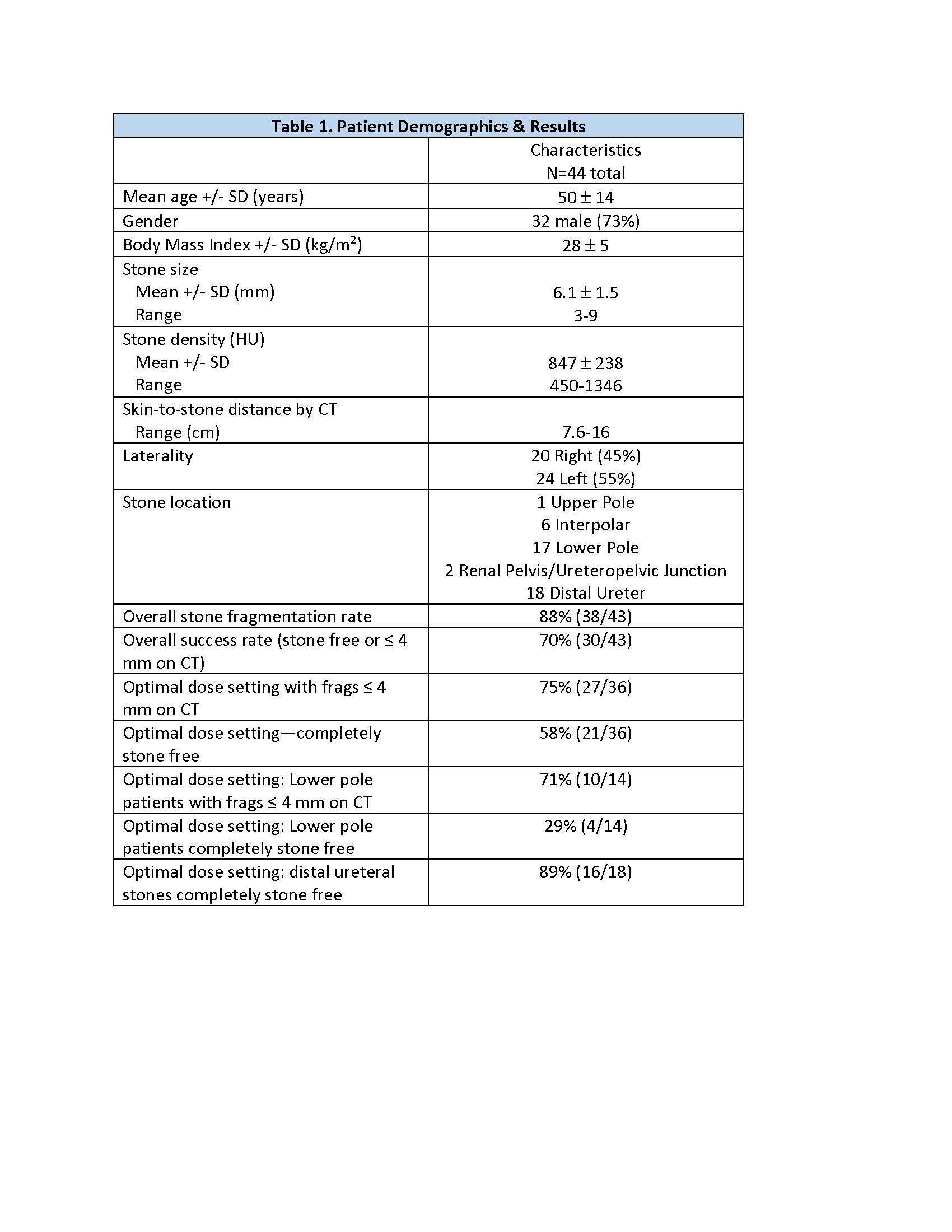Back
Introduction: Break Wave lithotripsy is a new non-invasive technology for the treatment of urolithiasis that can be performed with little to no anesthesia, potentially allowing stone treatment in non-operative settings. This study reports safety, efficacy, and anesthesia requirements from a first-in-human, prospective, multicenter, open-label single-arm clinical trial (NCT03811171) utilizing the SonoMotion (San Mateo, CA) Break Wave device.
Methods: Forty-four (44) patients with ureteral or renal stones were treated across five North American centers (US/Canada) between 08/2019 – 02/2022. Patients were recruited and treated in the operating room, office/clinic, or emergency department (ED). Thirty minutes of Break Wave therapy was delivered under continuous ultrasonography targeting. Varying therapy dose levels up to 8MPa of acoustic pressure were administered and safety, effectiveness and anesthesia requirements were assessed to establish optimal dose settings. The efficacy objective was stone free rate or fragments = 4 mm assessed via non-contrast CT at 8-12 weeks by an independent radiologist. Patients were followed for 90 days with all adverse events (AEs) recorded.
Results: Target stones were in typical locations and sizes (Table 1) with 59% renal (n=26) and 41% in the distal ureter (DU) (n=18). No serious AEs, hematomas, cardiac arrythmia or sepsis occurred at any dose level. Overall, 86% of subjects received either no medication (50%) or minor analgesia (36%) (e.g., ketorolac 15-30mg). All patients completed the procedure. Stone fragmentation occurred in 88% of cases, with 70% of subjects being either completely stone free or with fragments = 4 mm on CT. The retreatment rate was 7% within 90 days with either SWL or URS. The optimal dose setting was identified and delivered to 36 of 44 patients. Of these 36 patients, 75% had fragments = 4mm and 58% were completely stone free, 71% of lower pole patients (n=14) had fragments = 4mm with 29% stone free, and 89% of distal ureteral stones (n=18) were completely stone free.
Conclusions: Break Wave Lithotripsy appears to be a safe and effective non-invasive stone therapy requiring little to no anesthesia. It is potentially suitable for non-operative environments such as the office or ED and is being evaluated in ongoing trials.SOURCE OF
Funding: Sonomotion, Inc. NIH – NIDDK (R44DK109779)

Moderated Poster Session
Session: LBA01: Late-Breaking Abstracts I - Benign
LBA01-14: Break WaveTM Lithotripsy for Urolithiasis: Results of the First-In-Human International Multicenter Clinical Trial
Sunday, April 30, 2023
7:00 AM – 9:00 AM CST
Location: S505

Ben Chew, MD, MSC, FRCSC (he/him/his)
Associate Professor of Urology
University of British Columbia
Poster Presenter(s)
Introduction: Break Wave lithotripsy is a new non-invasive technology for the treatment of urolithiasis that can be performed with little to no anesthesia, potentially allowing stone treatment in non-operative settings. This study reports safety, efficacy, and anesthesia requirements from a first-in-human, prospective, multicenter, open-label single-arm clinical trial (NCT03811171) utilizing the SonoMotion (San Mateo, CA) Break Wave device.
Methods: Forty-four (44) patients with ureteral or renal stones were treated across five North American centers (US/Canada) between 08/2019 – 02/2022. Patients were recruited and treated in the operating room, office/clinic, or emergency department (ED). Thirty minutes of Break Wave therapy was delivered under continuous ultrasonography targeting. Varying therapy dose levels up to 8MPa of acoustic pressure were administered and safety, effectiveness and anesthesia requirements were assessed to establish optimal dose settings. The efficacy objective was stone free rate or fragments = 4 mm assessed via non-contrast CT at 8-12 weeks by an independent radiologist. Patients were followed for 90 days with all adverse events (AEs) recorded.
Results: Target stones were in typical locations and sizes (Table 1) with 59% renal (n=26) and 41% in the distal ureter (DU) (n=18). No serious AEs, hematomas, cardiac arrythmia or sepsis occurred at any dose level. Overall, 86% of subjects received either no medication (50%) or minor analgesia (36%) (e.g., ketorolac 15-30mg). All patients completed the procedure. Stone fragmentation occurred in 88% of cases, with 70% of subjects being either completely stone free or with fragments = 4 mm on CT. The retreatment rate was 7% within 90 days with either SWL or URS. The optimal dose setting was identified and delivered to 36 of 44 patients. Of these 36 patients, 75% had fragments = 4mm and 58% were completely stone free, 71% of lower pole patients (n=14) had fragments = 4mm with 29% stone free, and 89% of distal ureteral stones (n=18) were completely stone free.
Conclusions: Break Wave Lithotripsy appears to be a safe and effective non-invasive stone therapy requiring little to no anesthesia. It is potentially suitable for non-operative environments such as the office or ED and is being evaluated in ongoing trials.SOURCE OF
Funding: Sonomotion, Inc. NIH – NIDDK (R44DK109779)

